In this beginner guitar guide, we’ll be dissecting one of the primary methods of guitar fretboard navigation. This method is called the CAGED system. The CAGED system or CAGED sequence utilizes repeating open chord shapes that ascend (and descend) the guitar neck. This navigation method pairs well with other systems for playing up and down the fretboard and is used in both rhythm and lead guitar applications.
We’ll be using two different videos to break down the CAGED system. One focuses more on the basics and on this method’s uses for rhythm guitar. The other video takes us into the realm of lead guitar and shows us how we can combine pentatonic scales with the CAGED system to further understand the fretboard and play guitar solos.
Learn to play guitar even faster with our interactive practice tool inside the Guitareo members’ area. Start your 7-day free trial today!
It all starts with something you’re likely familiar with: open chords. In this case, we’re specifically using open major chords. As the acronym makes clear, the open chords used are C major, A major, G major, E major, and D major. If you’re not already familiar with open chords, we suggest you get started with this lesson: The 5 Most Important Guitar Chords
Here are the diagrams of the basic open chord shapes that make up the CAGED system.
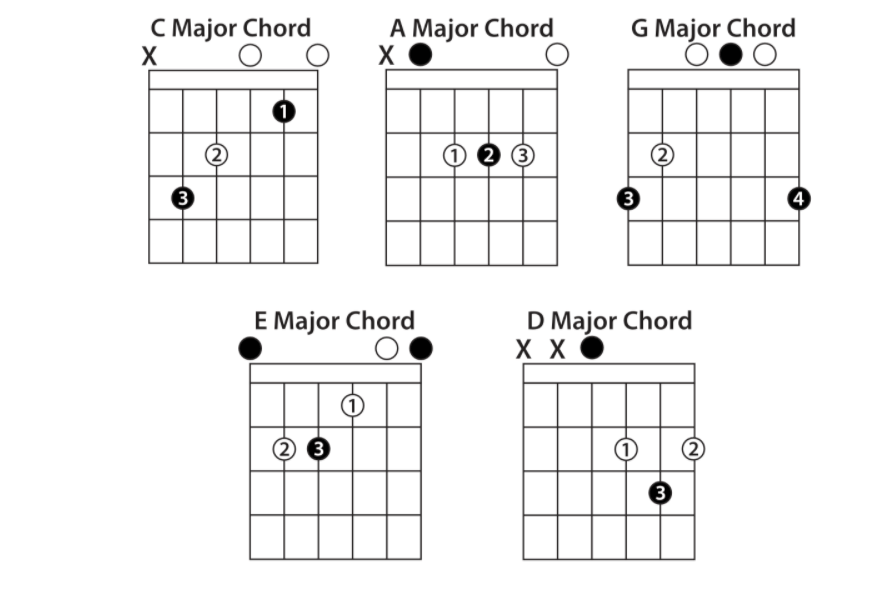
The next step involves another beginner guitar concept that you should be familiar with. If you need help with your bar chords, we recommend checking out our Bar Chord Survival Guide.
The CAGED system isn’t so much a way of playing but more so a way of mapping the notes on the fretboard using shapes you already know. So some of these bar chord shapes may not be super useful on their own. However, they’re part of a system that will help you to better understand the connection between chords and scales within a particular key.
If you have some experience with bar chords, then you’ll probably be familiar with the E major and A major shape bar chords. These are by far the most common along with their minor variants. The C major chord using the E major shape and A major shape bar chords would look like this.
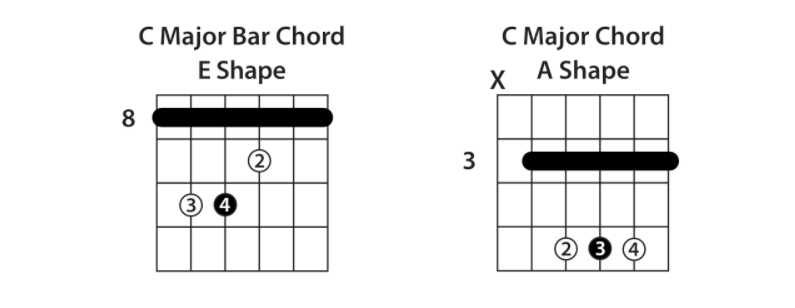
Something you may not know is that the other open chord shapes can be played as bar chords as well. They aren’t necessarily as comfortable, but they’re important for understanding the rest of the guitar fretboard. You just need to know the root note of each chord shape, and you can raise the shape up the neck to play new chords. For example, raising a C major shape two frets and barring the open strings will give you a D major chord. Raising a G major shape two frets gives you an A major chord. Raising a D major shape two frets gives you an E major chord.
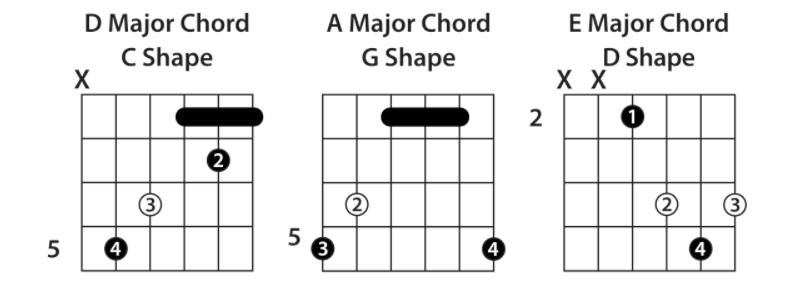
The important thing here is that you don’t just let the open strings ring out. Since you’re raising the shape, you’ll need to compensate by either using a capo, barring, or muting the open strings. Barring is what we’ll be using throughout this guide.
Now that you know which open chord shapes to use and how the moving bar chords work, we can look at how it’s all connected. The order of the acronym “CAGED” actually matters. To learn this, we’re going to take a look at a new video lesson.
The first half of this video covers the basics of the CAGED system and how the shapes connect. Scott Paul Johnson shows us how when we start with a basic C major chord shape, we can connect it to another C major chord using an A shape. Then that A shape connects to a C major chord using the G shape (can you tell where this is going?). Next, we can connect our G shape C major chord to an E shape C major chord. Then our E shape to a D shape. And finally, the D shape ties right back into a C major shape. When it’s all laid out, it looks like this: 2:31 in the video.
Shifting these connected shapes up or down will simply put you in a new key. Moving everything up one fret, and you’re playing all C# major shapes. Two frets up and you’re playing D major. No matter what key you’re playing in, all the shapes will be connected in this way. We’ll get into this more later in this guide.
Once you’ve fully internalized the concept of these connected chord shapes within the CAGED system, you’ll have access to five different shapes for each chord.
This wraps up the rhythm guitar portion of this guide. If you haven’t spent any time working on playing lead guitar, then we suggest stopping here for now. If you’d like to get started playing lead guitar, check out this guide: A Guide To Improvising Guitar Solos For Complete Beginners
The second half of this video from Scott Paul Johnson gets into how this applies to lead guitar. You can take this new connected CAGED roadmap, and break it back up into chords with a corresponding pentatonic scale shape.
The chord tones (notes specifically in the C major chord) are highlighted in red. The white notes are the other notes in the C major pentatonic scale that aren’t chord tones. This should help you clearly visualize each shape from the CAGED system.
The C Shape
The first pentatonic shape fits right overtop of your standard open C major chord.
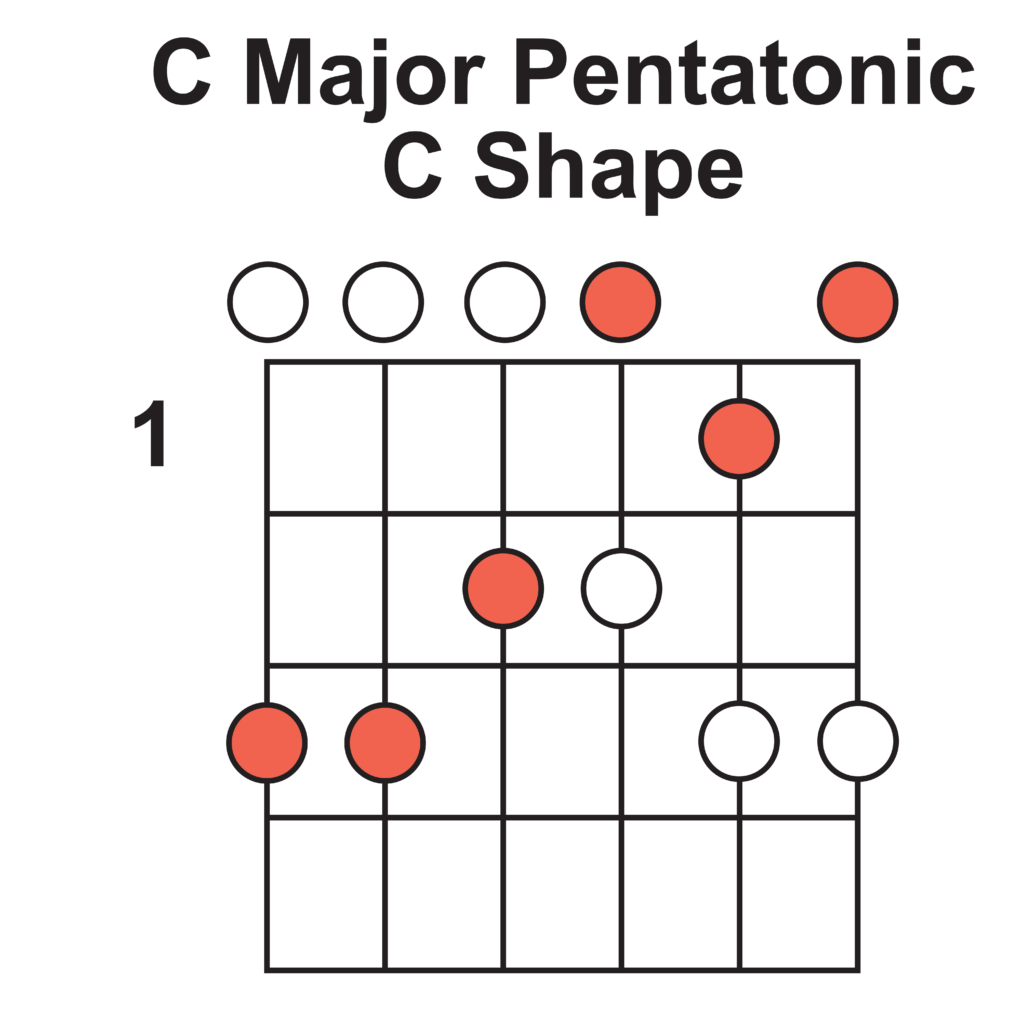
The A Shape
The next shape fits over our A shape C major chord.
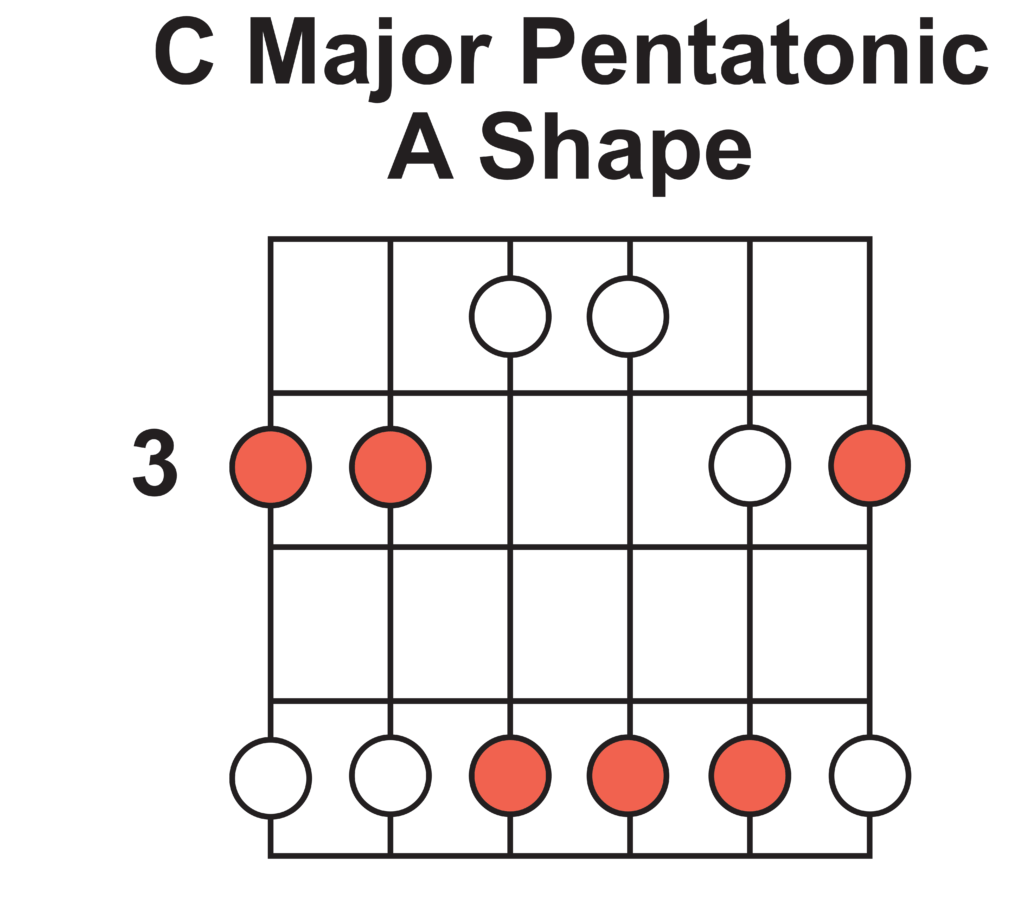
The G Shape
Following our A shape is the G shape. This is our standard minor pentatonic shape that you might already be familiar with from other guitar lessons.
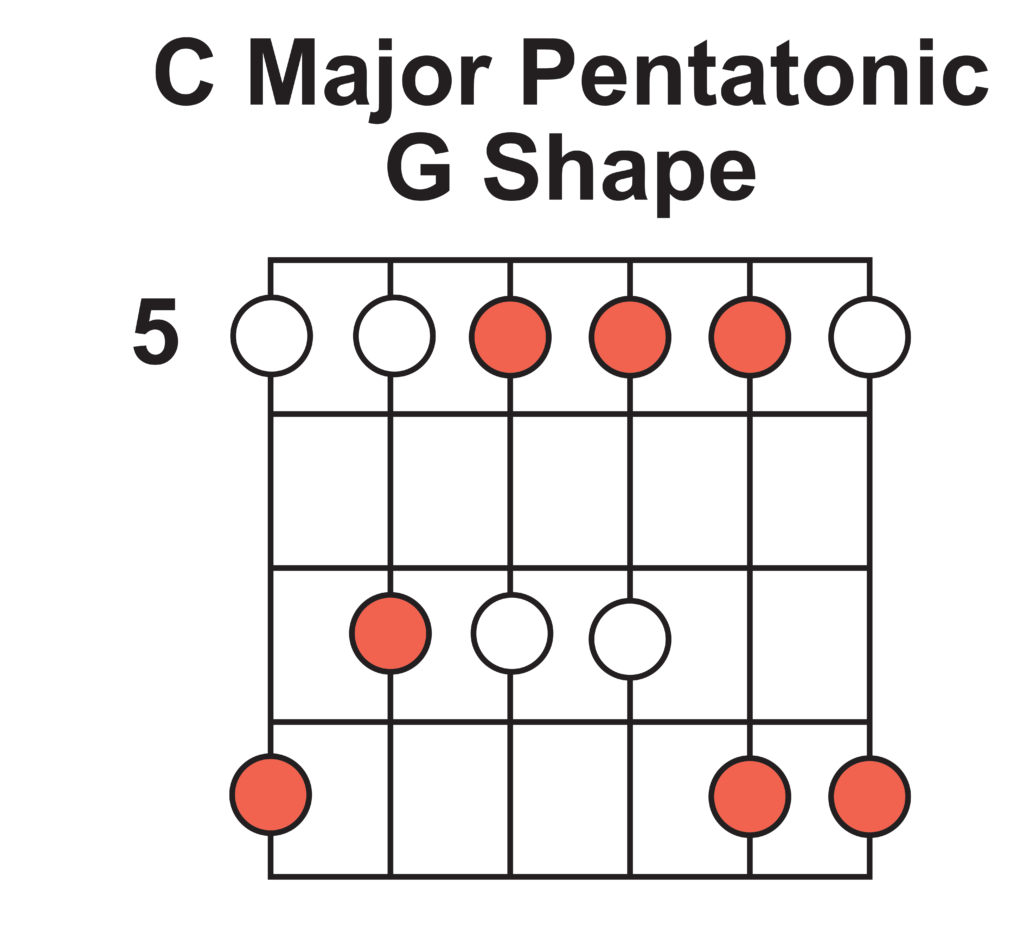
The E Shape
This pentatonic scale shape fits right over your E shape C major bar chord. This is a handy one when you’re switching between rhythm and lead guitar.
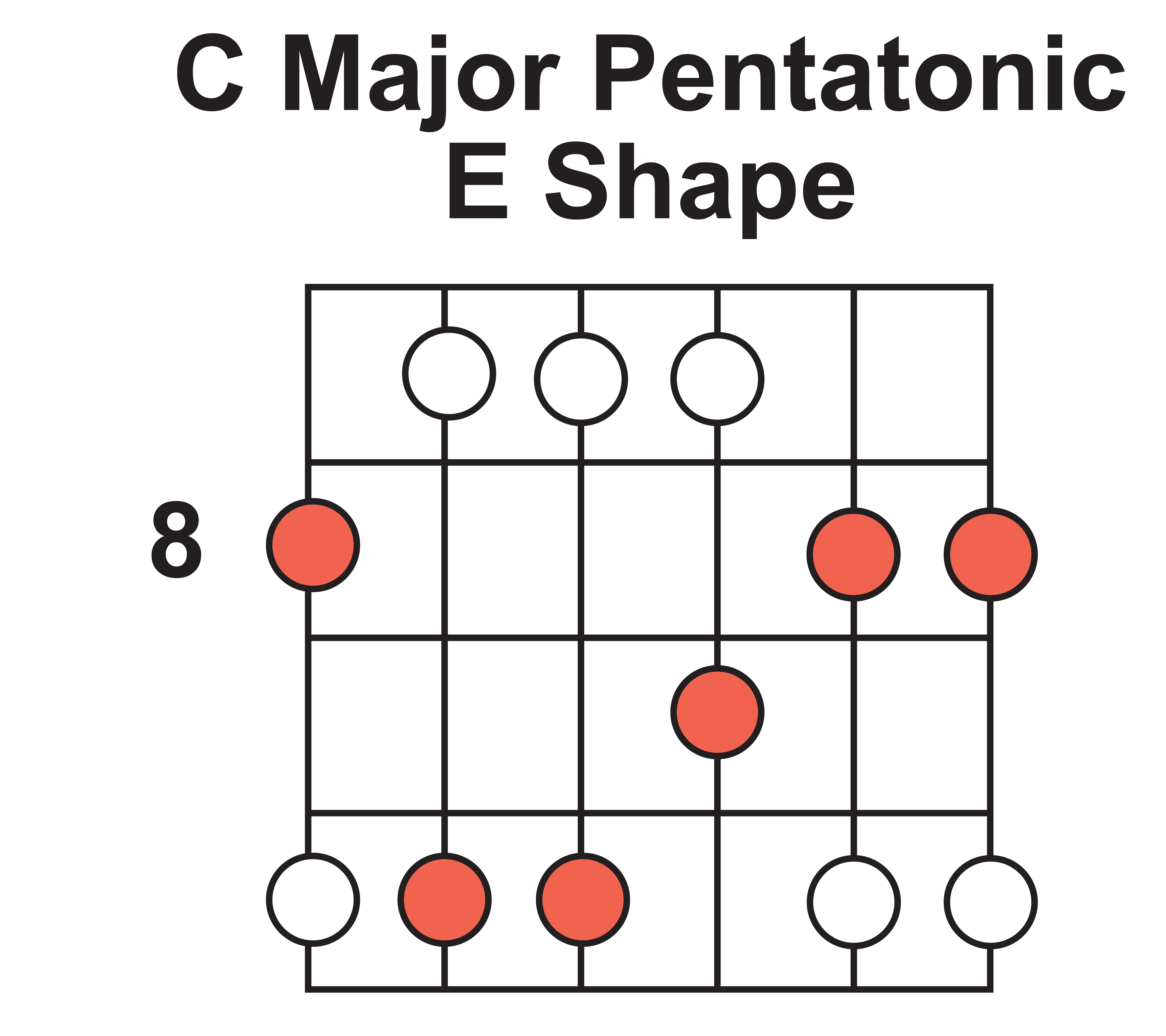
The D Shape
The final shape sits on top of our D shape C major chord.
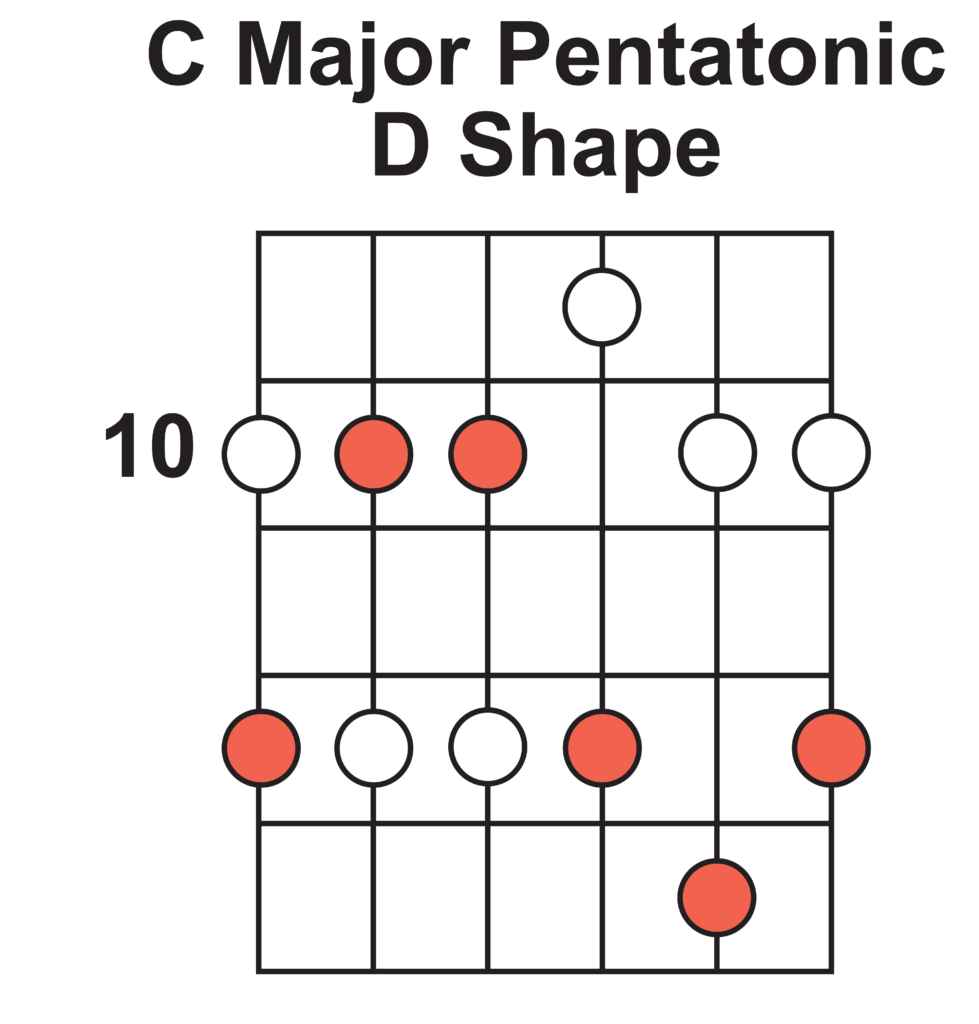
Just like almost everything else on the guitar, the CAGED system can be moved around freely. The names of the notes will change, but the shapes remain the same no matter where you are.
That means you can simply use the musical alphabet to figure out where you are. For example, if you shift all these shapes up four frets, you would be going up four half-steps from C. Four half-steps from C is E. Meaning that if you shifted everything up four frets, you’d be playing E major chords and the E major pentatonic scale.
It’s important to remember that the pentatonic scale you’re playing only corresponds to the key of the song, not each individual chord in a song.
So if you’re in the key of E major, you might be playing other chords from that key, but the E major pentatonic scale is the only pentatonic scale you’d want to play over the song.
You might be wondering why we’ve only covered major chords so far. Thankfully, this is because it’s so simple to use CAGED for minor chords. As long as you know the minor open chord shapes, then every single thing you’ve learned is the same. So instead of making an E major or D major shape, you’ll make an E minor or D minor shape. It’s that easy.
To wrap things up, we should quickly mention the other methods for navigating the guitar fretboard. The CAGED System isn’t the only method for moving around. The other primary methods are the 3-note-per-string method and the intervallic method.
The 3-note-per-string method uses small 3-note patterns from the major scale to cover the fretboard. This system tends to be a favorite among shredders and rock guitar players as it’s quite easy to use for fast runs and licks.
The intervallic method is a much more advanced method and involves ditching shapes altogether. That means you’re reliant solely on your ear to play. This method is great for augmenting the 3-note-per-string or CAGED system. We don’t recommend going this route alone unless you have spent a lot of time ear training.
In the end, it’s up to you which method you use, but a balanced combination of all three seems to be the best bet for most guitar players out there.
No matter what genre of music you’re interested in, the CAGED system will open up many doors for you as a guitar player. So your next steps are totally up to you! Here are a few lessons we recommend.
How To Master Bar Chords
In this lesson, Ayla Tesler-Mabe digs into some tips and tricks for mastering one of the most daunting beginner and intermediate guitar challenges: bar chords. Since it’s a key part of the CAGED System, you might want to take some time to improve your bar chord skills with this video.
6 Levels To Playing Great Guitar Solos
Join Ayla Tesler-Mabe for a lesson on playing guitar solos! You’ll use a 12-bar blues progression to level up your lead guitar playing and turn boring scale shapes into tools you can use to create your own expressive guitar parts.
Want to improve your guitar skills even faster? Unlock our interactive practice tool and stay motivated while you learn from the most inspiring teachers inside the Guitareo members’ area. Click the big green button below and start your 7-day free trial today:
Andrew Clarke is a guitarist, educator, and content creator from Vancouver, Canada. He's best known for his YouTube channel, where he creates easy-to-follow guitar lessons and informative guitar gear videos. Andrew also manages The Riff.

By signing up you’ll also receive our ongoing free lessons and special offers. Don’t worry, we value your privacy and you can unsubscribe at any time.
We use cookies for traffic data and advertising. Cookie Policy »